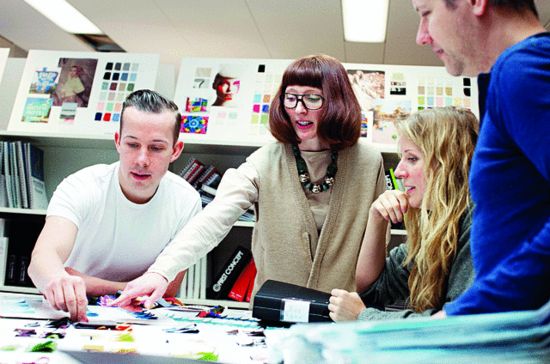
YSL Tweet Denying Pilati Rumours | Source: Twitter
LONDON, United Kingdom — Though they may have been slow off the mark — and indeed much slower than many of their clients might have liked — it is quickly dawning upon the fashion industry’s most respected public relations firms that their once cushy domain is being rapidly disrupted by digital media.
Simply put, no longer is it enough for PR firms to court editors of monthly magazines for editorial coverage over long boozy lunches and manage guest lists for fashion shows and events. Today’s high-powered fashion publicists are coming down from their ivory towers to help clients manage the new, constantly changing paradigm of digital fashion communication, while continuing their focus on personal relationships, which, it turns out, are more important than ever before.
Today, in exclusive conversations with the industry’s leading publicists, BoF examines how new media has transformed the PR landscape and how the sector’s top agencies are adapting to life in the digital age.
Reputation management in an always-on communication cycle
“We now think in terms of information streams,” said Brian Phillips, president and chief executive officer of
Black Frame, the elite New York agency that works with some of the industry’s most sought after emerging brands, including Rodarte, Nicholas Kirkwood and Band of Outsiders.
“Temporal boundaries on news no longer exist because of the possibility to feed and fill websites, blogs and Twitter with information at all times. We determine with clients what comprises their stream and these decisions are happening around the clock,” explained Mr. Phillips.
Daniel Marks, the highly-respected director of London-based
The Communications Store (TCS) — which counts Net-a-Porter and Christopher Kane on its client roster — agreed. “The resource that the digital revolution created is extraordinary — allowing anyone to find information about a brand, a magazine or a personality,” he said. “Part of our job is to ensure that that information is correct.”
The importance of rapid response reputation management cannot be overstated. In the digital world, unsubstantiated rumours can run wild based on little more than a casual conversation, captured in an out-of-context tweet, ultimately reaching hundreds of thousands of people and feeding further speculation on quick-fire fashion news websites.
The most recent example of this came with speculation about potential successors to John Galliano as creative director of Dior, but Galliano is not alone. In recent seasons, everyone from Alber Elbaz to Karl Lagerfeld to Stefano Pilati has been dogged by rumours which have been turbo-charged by social media.
More publicists are intervening directly in the social conversation to nip false information in the bud. Indeed, it was a tweet from the official YSL account which finally put to rest the persistent rumours of Pilati’s impending dismissal,
saying simply “Pilati busy working on the next collection. All the rumors unfounded – he is here to stay.”
Then there are those rumours that are true, but get leaked early. Mr. Marks of TCS recalls one such recent situation. “We were waiting until after fashion week to announce a new collaboration between J Brand and Christopher Kane,” he explained. “A very high profile editor-in-chief, who was privy to the information, gave an interview to an online video crew and mentioned the new collaboration. The editor was unaware that the information was embargoed as the designer had not told her.”
Sensing an opportunity out of the editor’s unintended scoop spreading online, TCS issued a release announcing the new collaboration slightly ahead of time. “Online means you have to be nimble as a PR,” asserted Mr. Marks. “Reaction times have to be quicker and more efficient.”
Relationships — not numbers — count most in blogger engagement
Of all the social media phenomena surrounding the fashion industry, possibly none has received more attention than the rise of the fashion blogger. Fashion publicists are the first to acknowledge the growing importance of this new breed of fashion influencer, but emphasise that relationships drive decisions about which bloggers to work with.
“We can see very directly who helps sell products or who has the greatest influence and number of followers,” said Mr Marks. “Some of the selection process is based on numbers, but much of it is based on good personal relationships.”
Relationship-building with bloggers reached new levels during the New York Fashion Week just past, when
PR Consultingfounder Pierre Rougier encouraged his clients, Proenza Schouler designers Jack McCollough and Lazaro Hernandez, to speak at the
Independent Fashion Bloggers (IFB) Conference, just days before they debuted their critically acclaimed Autumn/Winter 2011 collection.
This kind of active blogger engagement strategy may have appeared as an abrupt volte-face for Mr. Rougier, who like many other fashion publicists had been reluctant to engage with the blogosphere at first. But at the IFB Conference, evidence of his change of heart (and mind) couldn’t have been more clear. “Our goal is to maximise our clients’ place on the web and to enhance visibility for all that they do, in addition to promoting and driving users to all their social media channels,” he said.
But agencies are still exercising caution when it comes to blogger engagement. “Sites such as
Huffington Post,
The Daily Beast, and
The Business of Fashion are now institutional publishing organisations that follow journalistic codes. We tend not to work with self-published blogs, unless we have long term relationships built with the individuals behind them,” said Mr. Phillips of Black Frame.
Monitoring, amplifying and measuring social buzz
But as
KCD senior vice president of public relations Rachna Shah points out, social media engagement transcends the fashion blogosphere.
“The digital revolution has given a voice and a relevance to a much larger, more diverse group,” she said. “The ascent of bloggers has certainly been a buzz topic for the media, but it’s really the interactive role of the public and the consumers that have produced the most significant shift.”
Ms. Shah’s point is a critical one. With the rise of social media and user-generated content, the balance of power between fashion companies and end consumers, in terms of who shapes overall brand perception, has shifted dramatically. In fact, communal consumer conversations are already drowning out official brand communications.
Mesh Chhibber, managing partner of
Relative MO, agreed. “The official agenda is no longer set by newspapers of record,” he said. “We can now see how Twitter can drive the communications agenda. It changes everything.”
Indeed, when they find the right opportunities, many PRs — including Relative MO, PR Consulting, Starworks, and more recently, KCD — are using their own Twitter accounts to amplify positive conversations about their clients. “We have a Twitter account that acts synergistically with what our clients are doing online already, and further enhances the scope of reach for everything we work on,” explained Mr. Rougier. But Mr. Marks of TCS — which does not have an agency-level Twitter account — sees things somewhat differently. “We are here to amplify our clients’ voices — not our own,” he said.
To track, measure and understand consumer sentiment and opinions, PR firms are also beginning to use social media monitoring tools like
Topsy.com and
Radian 6, as well as analytics tools like Google Analytics, Quantcast and
Klout to measure online influence.
“We definitely take advantage of online tools to report on web analytics and monitor and quantify social buzz,” said Ms Shah. “As we move forward, Twitter and other social mentions will become widely accepted as legitimate PR value, so we’ll continue to research tools that give us more accurate figures in terms of social reach as these only strengthen and diversify our impact as publicists.”
Streamlining traditional PR processes with digital tools
But Digital PR is not restricted to communications alone. For several seasons now, fashion PRs have been integrating digital tools into their operational processes, particularly those that involve complex logistics such as event planning, inventory management, and sample tracking. More recently, they have been ditching their trademark clipboards and brandishing snazzy new iPad guest lists instead.
Much of this new technology is powered by
Fashion GPS, an emerging leader in developing technology tools designed for the fashion PR industry. “I wanted to digitise and streamline the entire process including reporting, which was the most apparent requirement at the time,” explained Fashion GPS founder and chief executive Eddie Mullon. “Initially, I developed a very primitive version of Fashion GPS just for KCD’s sample tracking, but the underlying spirit and incentives carried over to all areas of the fashion process.”
Today, Fashion GPS’ tools and technologies have been implemented by more than 80 clients, including KCD, Starworks Group, Arcadia Group and Louis Vuitton, and more than 1 million samples have been trafficked worldwide.
But while new tools and technologies are an important part of PR in the digital era, these can never replace real insider knowledge. “Nothing beats recognising an editor in person to show them to their seat at a show and knowing their deadlines, filing days, what inspires them,” cautioned Daniel Marks. “No amount of technology can teach a PR that.”
Building digital expertise from inside — and out
Most of the PR agencies admitted that they are still learning how to exploit the potential of social media in favour of their clients, and many are seeking external advice or hiring experts from non-fashion agencies to bolster their digital media expertise. KCD and Starworks are going one step further, building out entire divisions focused on digital PR.
“Previously KCD had two main divisions, PR and Production (handling fashion show and events), but KCD Digital will marry digital elements of both divisions and apply our fashion expertise to not only clients within the fashion industry but also to digital or technology brands seeking fashion industry access,” explained Ms. Shah, whose team was behind Nicola Formichetti’s first Mugler fashion show, the social media event of the season.
Starworks Group founder and chief executive James Grant has also prioritised the digital agenda, hiring individuals across all disciplines of digital marketing to be led by Rob Holzer, the newly-named global director of digital and integrated services for Starworks, serving clients including Loewe, Kate Spade and SHOWstudio.
“His keen business perspective and creative expertise in this area has already invigorated an impressive roster of fashion, beauty and lifestyle brands and will serve as a vital asset to the agency as we look to grow and expand our portfolio,” said Mr. Grant in a press release. Prior to setting its sights on digital PR, Starworks had already been moving from its core celebrity placement and casting business into fashion PR.
What’s clear is that Mr. Grant and his counterparts see digital PR as a huge opportunity for their clients, and a significant opportunity for their own agency growth and survival in the digital age.
“If brands can fully understand how to leverage their messaging and assets across digital platforms and engage with an active audience,” he said, “they can utilise the most powerful communications and sales tool that has ever existed in fashion.”
Imran Amed is founder and editor of The Business of Fashion











